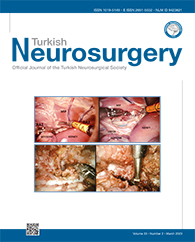MATERIAL and METHODS: From 2014 to 2020, the data of 28 patients with chronic subdural hematoma who underwent surgeries two large burr holes, saline irrigation, and CDS or one small burr hole, no saline irrigation, and EVDS were retrospectively who had preoperative computed tomography (CT) postoperative 1st-3rd day CT, and postoperative 7th-10th day CT were included in the study. Pre- and postoperative subdural liquid collection volumes and postoperative intracranial air volumes were measured using Sectra Medical Workstation. Results were compared between these two groups.
RESULTS: There were no significant differences in the preoperative and 7th?10th day liquid volumes between these two groups (p > 0.05). There were significant differences in the postoperative 1st?3rd day air volume between these two groups (p < 0.001).
CONCLUSION: The statistical results showed that surgeries with EVDS are as effective as surgeries with CDS in draining chronic subdural hematomas. We also determined that the intracranial air volume is significantly less in surgeries with EVDS. For this reason, we believe that EVDS can reduce the risk of postoperative infection.
Keywords : Subdural hematoma, Chronic, Minimally invasive surgery, Infection




